Kate Leeming has cycled the width of Africa, pedalled 25,000 km around Australia, and is the first woman to cycle unsupported across ‘new’ Russia. In 2016 year, the wonder-woman of cross country cycling will be leading a challenging new expedition that cycles across the mighty backbone of the Himalaya.
Kate took a few moments to share her fascinating story with us, including how she trains for such incredible journeys, some of the hairiest moments on her past expeditions, and what she is most looking forward to with her Leh to Manali expedition in 2016!
1) You’ve completed a lot of ‘firsts’ – you’re the first person to cycle across Africa in a continuous line from Senegal to Somalia, you were the first woman to cycle across the ‘new’ Russia from St Petersburg to Vladivostok, and you were the first woman to cycle the arduous Canning Stock Route in the middle of your 25,000km cycle around Australia. Why was the Canning Stock Route such a special journey for you?
I believe the Canning Stock Route to be the spiritual backbone in the history of early Australian exploration. I am inspired by the efforts of the early explorers and pioneers who explored the western deserts and forged the 1800km stock route to connect WA’s Kimberley region with the south. In particular I was inspired to follow the work of my great great uncle, William Snell who reconditioned two-thirds of the Canning Stock Route in 1929.
2) You must have had some pretty hairy experiences on your travels across Africa – is there one you want to share with us?
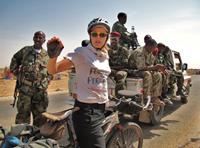 I think people would expect me to talk about cycling through a warzone in Puntland, Somalia accompanied by two bulletproof vehicles and a full military unit, taking a secret route to avoid al-Shabaab insurgents and Somali pirates to reach the finish…or maybe the shooting incident in the jungled Pool region of the Republic of Congo when Ninja rebels fired at the soldiers in the security vehicle just ahead of me. While such situations seem precarious, I didn’t feel particularly scared because I had trust in those protecting myself and my team. I was far more worried about the potential threat from dangerous wild animals that I knew could be lurking in certain situations; several times I crossed the path of a venomous snake on the road and I had a very nervous when I thought that lions were viewing me as meals-on-wheels at dusk in an area of the Bwabwata National Park in northern Namibia.
I think people would expect me to talk about cycling through a warzone in Puntland, Somalia accompanied by two bulletproof vehicles and a full military unit, taking a secret route to avoid al-Shabaab insurgents and Somali pirates to reach the finish…or maybe the shooting incident in the jungled Pool region of the Republic of Congo when Ninja rebels fired at the soldiers in the security vehicle just ahead of me. While such situations seem precarious, I didn’t feel particularly scared because I had trust in those protecting myself and my team. I was far more worried about the potential threat from dangerous wild animals that I knew could be lurking in certain situations; several times I crossed the path of a venomous snake on the road and I had a very nervous when I thought that lions were viewing me as meals-on-wheels at dusk in an area of the Bwabwata National Park in northern Namibia.
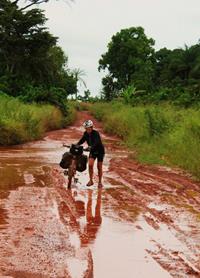 3) What keeps you going when you think you have nothing left in the tank?
3) What keeps you going when you think you have nothing left in the tank?
I have never wanted to give up because of my strong motivation to complete each particular journey, my belief in the cause(s) of the projects is deep-rooted and the fear of failure is too great. I have developed many techniques to keep the pedals turning; break the task into manageable, sometimes minute goals, search for the beauty in my surroundings, trap favourite songs in my head, put the perceived dilemma into perspective with the whole undertaking, that is, think of the big picture. It is always important to focus on the question ‘how do I get through’ rather than ‘what will stop me’.
4) How do you train for such arduous trips?
For my previous expeditions through Europe, Russia, Australia and Africa, my physical preparations have never been as thorough as I intended, essentially because the organisation process is so hectic, especially just before I leave, that I have little time to sleep let alone spend hours on a bike. In the past, training amounts to a few longer rides to test that I still have it and the rest of the work is done in the gym, mostly doing intensive interval training sessions where I am working right on my threshold. The first couple of weeks of each trip have been pretty much a case of biting the bullet and keeping the pedals turning until my fitness is up to speed. For my next journey across Antarctica, where the physical demands will be extreme and the journey a virtual intensive sprint compared to previous expeditions, I will have to be in peak condition at the start. Therefore to prepare I have planned for a series of training trips throughout the year at altitude and on softer snow and sand surfaces to ensure that I am ‘expedition fit’. In between there will be a lot of gym work to build and maintain strength and more interval training.
5) Do you use a different bike for each trip?
Yes, I always choose a bike that will cope with the worst conditions that I expect to face. For the last three expeditions I have used a sturdy hardtail mountain bike which, for most of the distances I was travelling were far less efficient than a touring bike, but a mountain bike was necessary for the 1500km of swamp in eastern Siberia, the 7000km of off-road tracks in Australia and both sand and mud in Africa. In each of these cases I carried smoother, more efficient road tyres and swapped them for fatter, nobbly treaded tyres for the rough conditions. It is also really important to carry quality spare parts, as the drive train tends to wear quickly in sand and mud. For Antarctica I will be using a custom made fat-bike, which is the first all-wheel drive bicycle with 12cm wide tyres.
6) What got you in to cycling in the beginning?
 I had always dreamed on travelling through France or Italy by bike but only started to understand what I could achieve on a bike after I travelled to the UK, initially playing hockey, and after organised a short cycle trip in Ireland. Then little trips led to longer journeys and over the next couple of years I did about 15,000km through Europe as my personal discovery, from Spain to Turkey to the Nord Kapp, Norway, the most northerly tip of mainland Europe. This is where I discovered my passion for travelling by bike.
I had always dreamed on travelling through France or Italy by bike but only started to understand what I could achieve on a bike after I travelled to the UK, initially playing hockey, and after organised a short cycle trip in Ireland. Then little trips led to longer journeys and over the next couple of years I did about 15,000km through Europe as my personal discovery, from Spain to Turkey to the Nord Kapp, Norway, the most northerly tip of mainland Europe. This is where I discovered my passion for travelling by bike.
7) You raise awareness of a range of issues through your rides – is raising awareness for an issue the impetus for these amazing journeys you have completed, or is it the other way around?
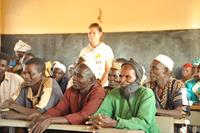 When planning my first major journey across Russia, I met polar explorer Robert Swan who became my mentor. He taught me that there was much more value to what I was doing than simply riding a bike. Since then I have always endeavoured to create some sort of benefit for the people and places that I travel through. In creating the vision and mission for each of my major undertakings I am matching my passions, what I stand for and what’s realistically possible, so the journey and outreach projects are mutually dependent. For my last two expeditions, Africa in particular, where I was exploring the causes and effects of extreme poverty, the routes have been defined by the cause.
When planning my first major journey across Russia, I met polar explorer Robert Swan who became my mentor. He taught me that there was much more value to what I was doing than simply riding a bike. Since then I have always endeavoured to create some sort of benefit for the people and places that I travel through. In creating the vision and mission for each of my major undertakings I am matching my passions, what I stand for and what’s realistically possible, so the journey and outreach projects are mutually dependent. For my last two expeditions, Africa in particular, where I was exploring the causes and effects of extreme poverty, the routes have been defined by the cause.
Antarctica will be different because one of the key outcomes will be to raise funds and awareness for HIV/AIDS in Africa as a response to one issue I learned so much about while I was in Africa. I have always wanted to travel across Antarctica but cycling across the continent until recently has been an impossible dream. In each case, the motivations for completing the journey and achieving the various outcomes (will also include an educational contribution) are equally important, though generally I choose the location for the expedition first.
8) You are planning to cycle across Antarctica via the South Pole…how does the training differ for a cold climate cycle VS hot climate cycle, or is it the same?
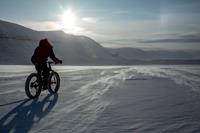 Having grown up in a hot climate I have been used to dealing with heat for most of my life. Cycling day after day in the heat in simple terms requires covering up to protect the skin (loose long sleeved cotton shirt, hat, sunscreen, etc), continual hydration, seeking shade where possible and pushing at a reduced intensity. The extreme cold is a whole new frontier for me. In Spitsbergen, my first test run in the extreme cold, I quickly learned that dealing with the cold is going to be more of a challenge. Managing body temperature is quite an art because while cycling on snow I am working so hard but I can’t afford to perspire as any moisture freezes. Mont Australia is designing special outer shell clothing with vents in the right places so I can manage the airflow as I ride. At the same time, I can’t afford to have any skin directly exposed or allow the cold to creep in. Most difficult to keep warm will be my hands and feet. My preparations for the extreme cold include spending time acclimatising, designing clothing and equipment and learning new skills to manage the conditions.
Having grown up in a hot climate I have been used to dealing with heat for most of my life. Cycling day after day in the heat in simple terms requires covering up to protect the skin (loose long sleeved cotton shirt, hat, sunscreen, etc), continual hydration, seeking shade where possible and pushing at a reduced intensity. The extreme cold is a whole new frontier for me. In Spitsbergen, my first test run in the extreme cold, I quickly learned that dealing with the cold is going to be more of a challenge. Managing body temperature is quite an art because while cycling on snow I am working so hard but I can’t afford to perspire as any moisture freezes. Mont Australia is designing special outer shell clothing with vents in the right places so I can manage the airflow as I ride. At the same time, I can’t afford to have any skin directly exposed or allow the cold to creep in. Most difficult to keep warm will be my hands and feet. My preparations for the extreme cold include spending time acclimatising, designing clothing and equipment and learning new skills to manage the conditions.
9) Besides your bike, what do you never leave home without?
My cameras and communications equipment. It is really important to be able to record the journey and communicate it with others to realise the full value of the expedition during and after the journey.
10) You are escorting a trip with WE next year from Leh to Manali, across the Himalaya. What can people look forward to on this trip?
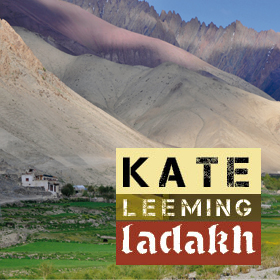 Several years ago on a trek in Ladakh, I was so taken by the harsh beauty – the rugged snow-capped peaks, the colours of the high-altitude bare desert slopes and the contrasting verdant green of the Indus River valley – that I vowed to return. I’m really looking forward to exploring this region properly with a group of adventurous cyclists. Exploring the roof of the world is going to be a lot of fun. I can’t wait to return.
Several years ago on a trek in Ladakh, I was so taken by the harsh beauty – the rugged snow-capped peaks, the colours of the high-altitude bare desert slopes and the contrasting verdant green of the Indus River valley – that I vowed to return. I’m really looking forward to exploring this region properly with a group of adventurous cyclists. Exploring the roof of the world is going to be a lot of fun. I can’t wait to return.
----------------------------------------------------------------------------------------------
Book the Leh to Manali cycle Expedition with Kate Leeming here
Departs 25 June 2015
Duration: 15 days
Click here for More Info